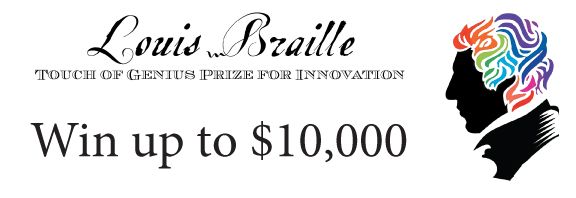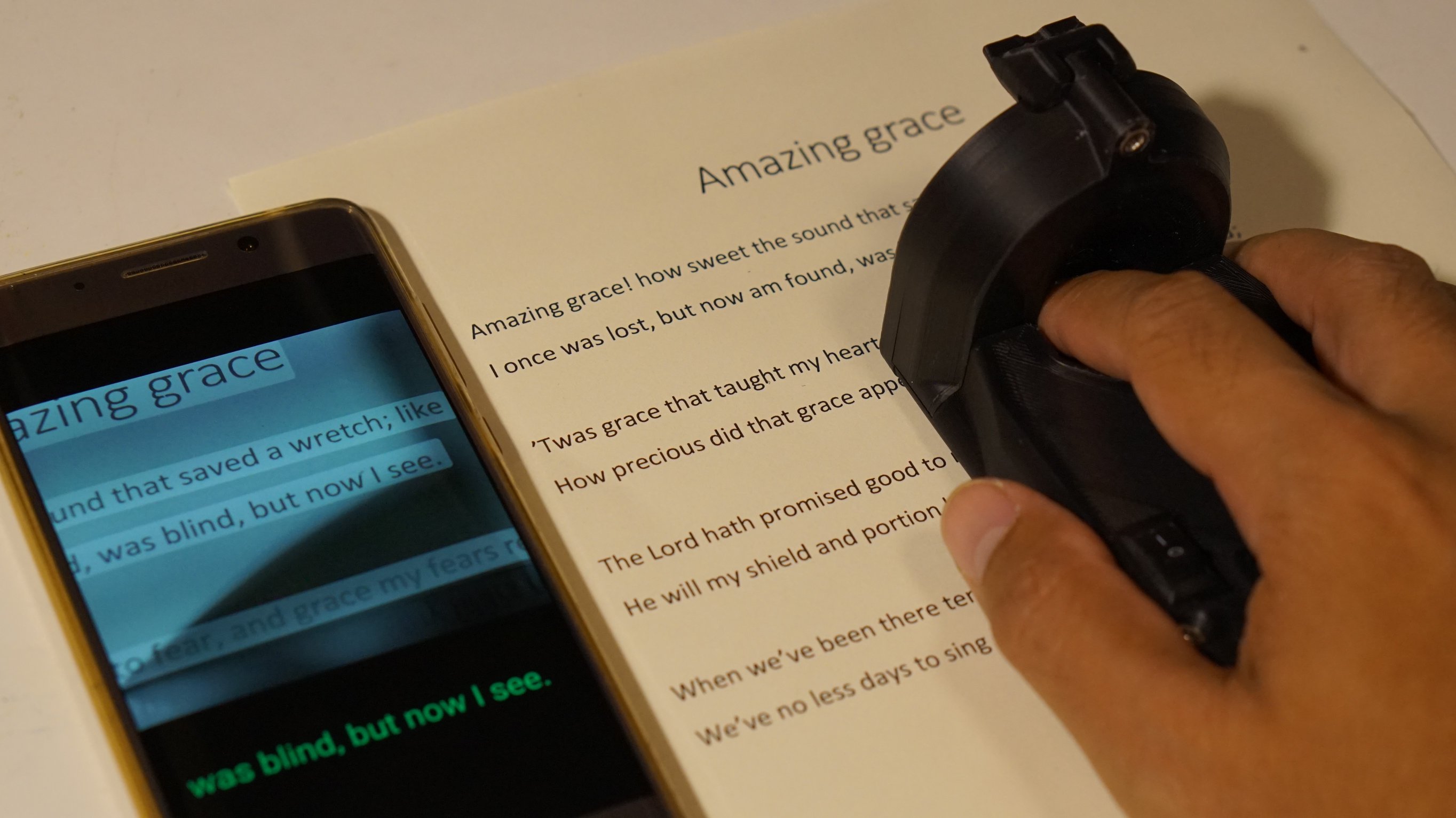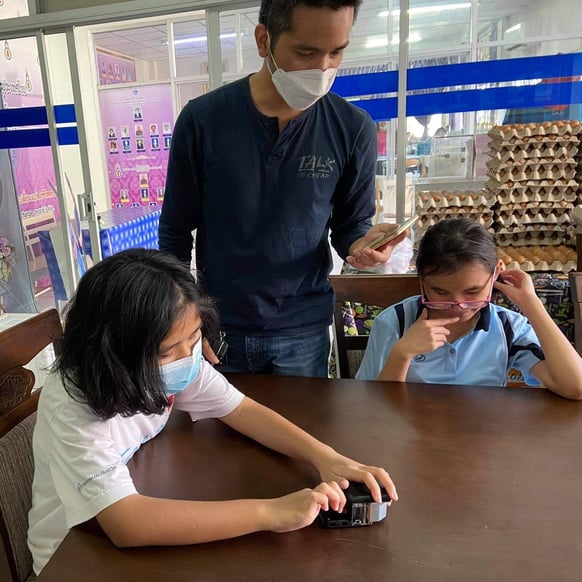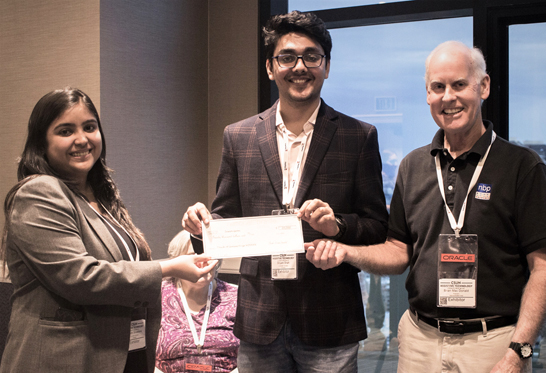
Download the Touch Of Genius Prize application here! Note new deadline: January 22, 2025.
The Touch of Genius Prize for Innovation is an annual prize of $10,000 awarded to a project, or projects, that show the most innovative idea in the field of braille and tactile literacy. Winners and applicants have submitted projects for professional software & apps, educational software and apps, gaming software or apps, and braille or tactile-related hardware or leaning paraphernalia.
Innovators have come from all over the world in the fields of education, technology, engineering, tactile graphics, and literacy. This is the only prize to foster and reward innovation in the area of braille and tactile literacy for the blind and deaf blind communities.
NBP established this award in 2007, thanks to support from the Gibney Family Foundation, inspiring people to go beyond what was thought possible with their many years of generosity. We are very grateful to the Lavelle Fund for funding this program since 2021.
This prize was developed to inspire an innovator to continue the promotion of braille literacy for blind and deafblind people worldwide. The publication of Louis Braille: A Touch of Genius by National Braille Press was a huge success in promoting braille literacy to a wider audience. The promotion surrounding the book provided a springboard for launching the Touch of Genius Prize, providing the exposure needed to inspire an innovator.
Download the Touch Of Genius Prize application here! Deadline: January 22, 2025.
Applications will be accepted from individuals, groups, or someone advocating on behalf of either.
Submission Requirements:
- Signed Application form.
- If application is submitted by a third party, the form must be signed by both the applicant and the individual/representative of the nominated group.
- If application is being submitted for a group, only one member of the group needs to sign the form, and will be the primary contact during the adjudication process.
- Outline in 600 words or less that shows the following:
- What the project/innovation is;
- How the project exhibits innovation. Keep in mind that innovation is defined, generally, as a remarkable improvement of discovery, in this case, one that has direct impact on tactile literacy for blind people and meets other prize criteria.
- Supporting materials in 10 pages or less that includes the following:
- A descriptive summary for both the potential and fully realized projects.
- Potential for an emerging project, including target markets, production costs, and how it will be brought to market.
- Measurements of success and impact on the industry for a completed/developed product.
- Express any challenges or limitations that you have experienced with production or distribution, or that you anticipate.
- Include any other information that you think will be helpful.
- Two (2) letters of recommendation from individuals that are in a position to comment on the innovation. These should come directly to NBP from the recommender and can be emailed to geniusprize@nbp.org.
- A working prototype. Please be sure to include simple instructions for testing.
Submission Guidelines:
- All application materials, apart from the prototype, must be submitted electronically in an accessible format - no scanned or hard copy documents will be accepted.
- Incomplete applications will not be considered by the adjudication committee. Inaccessible applications will be considered incomplete submissions.
- Make sure that all documents are clearly labeled (ex: application, summary, outcomes/realizations, supplementary information, etc.)
- If you provide any images/video please make sure that everything is described with captions, alternative text, audio descriptions, or other.
- All applications must be in English.
- Project must demonstrate some aspect of tactile or braille literacy or access to information for the blind community. Braille is a type of tactile literacy, but innovations are not limited to braille.
- Submissions can be either standalone projects or part of a larger curriculum/program.
- All applications will be reviewed by the adjudication committee, made up of experts from various and relevant fields. All decisions are final and will be at the discretion of the committee. The committee reserves the right to split the $10,000 prize.
Literacy through a sense of touch, this can include braille, as well as tactile images. Tactile literacy implies that individuals who are blind will have greater access to information and learning.
Our judges hope to foster new thoughts, creations, and thinking outside the box to improve the lives of blind people. Your project can involve software and apps for education, professionals, or gaming, or a tactile/braille hardware device that promotes learning and literacy. You can check out the PAST WINNERS to see some of the innovations that have one in previous years.
Innovation, of course. It must be creative, inventive, original, pioneering, and should have viability, that is to say that it not only works, but it's worth building. Your project can still be under development, but we do ask that you submit a working prototype for us to accurately assess your design. We would love to see a project that not only improves upon existing tactile approaches, but helps to change the way we think about tactile literacy and has the potential to in the world of knowledge for the blind community.
There is no set format as long as it includes all the necessary information.
Some of our judges are sighted and some are blind, so it must be accessible by everyone. Any document that can be read by a screen reader - generally .txt, .doc, .pdf are all accessible - so no scanned documents. If there are any photos, be sure to provide descriptions; if there are any videos, it must be able to stand alone with audio only and not rely on visual context.
Please make sure to include complete usage instructions. Also include return instructions, should you like to have your prototype returned after adjudication. If needed, we may schedule a phone/video call with you during adjudication to answer questions on your prototype.
All application materials, questions, and recommendations should be sent electronically to geniusprize@nbp.org. If you are sending a physical prototype, you can mail it to TOG Prize, National Braille Press, 88 Saint Stephen St., Boston, MA 02115.
Winner: T3 Tactile Tablet Games
Innovator: Steven Landau, Touch Graphics Inc
 From left to right: Cherri Hutcherson NBP Board Vice Chair, Steven Landau Touch Graphics Inc, and Brain Mac Donald NBP President and CEO
From left to right: Cherri Hutcherson NBP Board Vice Chair, Steven Landau Touch Graphics Inc, and Brain Mac Donald NBP President and CEO
The 2024 NBP Touch of Genius Prize was awarded to Steve Landau, founder of Touch Graphics Inc for its new product, T3 Games. This is a set of 40 puzzles and mazes. that players mount embossed plastic overlays on a large touchscreen tablet, then interact with a virtual teacher as they move through increasingly challenging activities. By introducing basic concepts and vocabulary, then providing a fun way to practice and refine new skills, T3 Games builds tactile literacy. Steve founded Touch Graphics Inc in 1998 to work on audio-tactile maps, exhibits and classroom aids like T3 Games. In 2007, he won the first Touch of Genius prize with Karen Gourgey, for an early model, the Talking Touch Tablet.
 Steven Landau demonstrating the T3 at the NBP Annual Meeting
Steven Landau demonstrating the T3 at the NBP Annual Meeting
Winner: The Paige Connect
Innovators: Gregory Hargraves, Nina Moutonnet, and Sergio Gosalvez

The Paige Connect was founded by Sergio Gosalvez, Gregory Hargraves, and Nina Moutonnet. These London engineers from Imperial College created an adaptation for braille writers that lets you save and share print translation. The small device replaces the base of the braille writer and allows it to connect to a phone, tablet, or laptop with Wi-Fi. Once the Paige is connected, the braille writer can be used as a keyboard, enabling users to type braille into a web app. The web app also includes software that translates braille into print for the user to collaborate with sighted peers, parents, and teachers. The mission of the Paige Connect is to make braille affordable for everyone, help people communicate, collaborate, and engage with the braille community to better serve them in their everyday lives.
Winner: The Haptibraille Communicator
Innovator: Fedor Belomoev, 4Blind Company
National Braille Press (NBP) announced this year's winners of the Louis Braille Touch of Genius Prize for Innovation at the CSUN Assistive Technology Conference in Anaheim, California. NBP awarded $9,500 to Fedor Belomoev of 4Blind (Boston, MA) for his HaptiBraille Communicator. The HaptiBraille allows a deafblind person to communicate through a synthesized voice and the sighted person can dictate into the communicator and have a message converted to a braille output using vibration.

Winner: Braillists Foundation CIO
A $500 prize was awarded to the Braillists Foundation CIO, in Worcestershire, UK in recognition for their novel method for teaching braille with lessons, distance learning, and physical resources in a kit, that delivers a successful modern solution for aging adults to learn braille, or for those needing a refresher in braille.
Winner: The ReadRing
Innovator: Songpakorn Punong-ong

An engineer from Phetchaburi, Thailand, Songpakorn Punong-ong is the eldest son of a blind teacher who founded the Christian Foundation for the Blind in Thailand (CFBT). He was born and raised in schools for the blind where his parents both worked.
Mr. Punong-ong earned his degree in Electronics Engineering from KMITL Bangkok and has spent 15 years in electrical power systems services and engineering. He learned the cost to produce braille books and the complexity of technical services for generations of students at CFBT’s schools, he started coming up with ideas of more affordable and portable solutions to allow blind people to learn and read braille in an easier way.
The ReadRing is one such solution. It is an affordable compact device, the same size as a computer mouse. It has an opening where you put your reading finger, and there is a rotary refreshable braille display that moves with your finger allowing one to continuously read braille as it streams from a wirelessly connected smartphone, computer, or tablet. It can also read optical characters captured by an attached camera. This product has been in development since 2015, and working prototypes are being tested by blind students.
 Song testing the ReadRing with students
Song testing the ReadRing with students
Winner: CanDo Reusable Braille Labels
Innovator: Lisa Dalton
Lisa Dalton used her 3D printing knowledge to engineer a reusable braille label set for her former boyfriend who is blind, after messing up his cabinets while making a grocery list. Seeing how easily they worked for him, he encouraged her to start candoable and make CanDo reusable braille labels available to everyone who needs them --so, that's what she's doing. Lisa is passionate about 3D printing and helping others, and is fortunate enough to spend her days doing both at the collaborative coworking/maker space Gangplank Queen Creek.

Winner: The Pocket Braille Periodic Table
Innovator: Roy Alexander
This is an Innovative, high use, low cost, and uniquely convenient Periodic Table of Chemical Elements for braille trained blind students pursuing the learning and work of Chemistry.
The project has completed a Beta-test functional prototype stage, showing good student acceptance, suggesting clear viability of large-scale production and we're excited that this prize will support the next stage of it's development.
Winner $5,000: Braille Sheets
ObjectiveEd won for the Braille Sheets, the design of braille and tactile overlays for a tablet that have audio support to help students learn braille and tactile literacy. NBP is also interested in exploring ways to help get this product to market to support braille literacy.
 Left: Brian MacDonald (NBP) with Marty Shutz of ObjectiveEd.
Right: MacDonald with Ed Rogers of Bristol Braille.
Left: Brian MacDonald (NBP) with Marty Shutz of ObjectiveEd.
Right: MacDonald with Ed Rogers of Bristol Braille.
Winner $5,000: The Canute
Bristol Braille Technology from the UK won for the Canute, a low cost innovative design for a multi-line braille display (9 rows by 40 cells across). NBP is very interested in collaborating with Bristol Braille as a distributor and in research to support STEM applications.
Winner $20,000: Braille Me
Innovision was granted the prize for the creation of Braille Me, a refreshable braille reader and simple notetaker. Innovision won $20.000 to continue their advancement and production of the BrailleMe. Their new, magnetic approach for raising braille pins shows tremendous promise to revolutionize the future of refreshable braille and bring more affordability to the cost of braille readers. NBP is very excited to work with Innovision on their distribution, as well as future projects involving their refreshable braille technology to get braille into more hands around the world.
 Brian MacDonald, NBP President, handing the winning check to InnoVision Technologies
Brian MacDonald, NBP President, handing the winning check to InnoVision Technologies
Honorable Mention: BrailleBlaster
American Printing House for the Blind (APH) was granted an honorable mention for their development of BrailleBlaster, a free, downloadable braille translation software that translates text, as well as NIMAS files. This software is completely free and allows for basic formatting. APH hopes this will help to get textbooks and other materials in the hands of students more quickly.
Honorable Mention: TMAP — Tactile Maps Automated Production
Scott Blanks, Greg Hehret, and Naomi Rosenberg from Lighthouse—San Francisco and Joshua Miele from Smith-Kettlewell Eye Research Institute were granted an honorable mention for their development of TMAP, a free software which produces tactile maps of local areas and streets. TMAP can center in on any user specified location and produce files for useable, custom street maps. These files can be downloaded and printed at home or sent to Lighthouse to be embossed. Maps are provided with a key so measurements and other symbols can be easily recognized.
Winner $15,000: BELLA (Braille Early Learning and Literacy Arcade)
BELLA was developed by John Hudelson. BELLA is an educational software and hardware gaming platform to teach pre-braille skills, braille reading, and braille writing. The device uses audio, visual, and tactile feedback to teach these skills and is a great tool for teachers to support students learning braille.
Honorable Mention $5,000: Reach and Match Learning Kit and Inclusive Learning Program
The Reach and Match Learning Kit and Inclusive Learning Program was developed by Many Lau. This kit, with accompanying curriculum, is designed to help children develop braille literacy and communication, as well as social skills acquired through tactile and play-based activities.
Winner $10,000: TactileTalk Toolkit and Guidebook for iPad
TactileTalk Toolkit and Guidebook for iPad: Strategies for functional Communication and Literacy was submitted by Betsy Flener and Joni Nygard. This complete program teaches and reinforces tactile communication and literacy. This program is the first voice output system using tactile symbols and overlays with the iPad, aimed at blind children not yet ready for formal braille instruction and have additional disabilities.
Betsy Flener is a low vision education and multiple disability specialist with over 25 years of experience, receiving her doctorate from Vanderbilt University. Joni Nygard is Director of Speech & Language Product Development and Director of the Aging Resources Division for Attainment Company, Verona, Wisconsin. Joni has over 30 years of experience in augmentative alternative communication and assistive technology.
Winner $15,000: Braille Tutor
The Braille Tutor was developed by TechBridgeWorld Research Group, out of Carnegie Mellon University. The Braille Tutor is a device that gives audio feedback in real time to students learning to use a slate and stylus. It comes in two versions, one that pairs up to a computer and one that is a battery powered standalone device. Its objective is to teach braille writing through guided practice and is available in many different languages.
Honorable Mention $5,000: Intuitive STEM Accessibility System
The Intuititve STEM Accessibility System was submitted by Rahul Namdev, a computer science graduate student at MIT, having completed both a Bachelor's and Master's at IIIT-Hydrabad in India. This device uses mini, high-speed refreshable hyperbraille, which moves up and down by mechanical piezoelectric binary pins to display tactile graphics. It has a touch sensitive surface and equipped with motion sensors, Bluetooth, and a built in processor for zooming in and out. A high quality latex program is being developed for braille transcription and input.
Winner $10,000: iBraille Challenge App
The iBraille Challenge App was submitted by Cheryl Kamei-Hannan and Nancy Niebrugge. This mobile app is aligned with the national Braille Challenge contest, and aims to support braille literacy from 1st through 12th grade. It focuses on reading and writing braille and is paired with an iPad and refreshable braille display. It tests core skills that from the Braille Challenge, with practice and support for students that want to improve their performance.
Cheryl Kamei-Hannan is an assistant professor in the Division of Special Education and Counseling at California State University Los Angeles, receiving her Master's in Special Education from San Francisco State University and her Ph.D. in visual impairment and blindness from the University of Arizona. Nancy Niebrugge is the assistant vice president of programs and services for the Braille Institute and director of the Braille Challenge.
Winner $10,000: Tactile Caliper
The Tactile Caliper was developed by Pranay Jain and Anshul Singhal. This device looks like a traditional vernier caliper and uses a sliding jaw to measure objects. There is statically embossed braille on the main body and mechanical refreshable braille on the sliding jaw. This refreshable braille measures as fine as one-sixteenth of an inch and is simple and easy to use.
Pranay Jain is a graduate student at MIT and runs a start-up in assistive technology for people with blindness. Anshul Singhal is an assistant manager for engineering design and product development for JCB India Ltd in India and has a Bachelor's from the Indian Institute of Technology, soon to be pursuing his masters at MIT.
Winner $10,000: Code Master Adult Braille Instruction System
The Code Master Adult Braille Instruction System was submitted by Emily Wharton, who has worked at BLIND Inc since 1998 and has previously taught cane travel, personal management, assistive technology, and braille. This system breaks the braille code into parts for memorization and touch development. The program takes six weeks and utilized audio materials and technology to expedite the learning process and student's varying learning styles.
Honorable Mention $5,000: inTACT System for Interactive Tactile Graphics
inTACT was developed by Michael Rosen, Michael Coleman and Joshua Coffee from E.A.S.Y. LLC, a start up to develop and market access technology. The inTACT system has three components: a tablet, eraser, and printer. It is for interactive production, editing, digitizing, and reproduction or raised line graphics. It affords users the ability to create and modify a drawing while changes are recorded and shared digitally.
Honorable Mention $5,000: GraVVITAS: Graphics Viewing using Vibration, Interactive Touch, Audio, and Speech
GraVVITAS was submitted by Cagatay Concu, Kim Marriot, and John Hurst who began this project during Concu's Ph.D. studies and collaborated with domain experts from Vision Australia and conducted usability studies with blind participants. GraVVITAS is a multi-modal presentation device using a touch screen with haptic feedback. The device uses a glove with vibrating motors that activates when the finger is over a graphic elements on a tablet. It provides speech and 3D non-speech audio to help with navigation.
Winner $10,000: TAGs - Tactile Accu-draw Graphics Set
TAGs was submitted by Ashok Sapre, a mechanical engineer. TAGs uses templates and hand-held tools to draw lines and irregular curves, circles, and patters or varying height on paper. This device produces rich graphics and braille notes in the same setup. It was created after Ashok visited a school for the blind in India and was aimed at developing nations, where tactile graphics were not present in education to blind students.
Winner $10,000: Feel the Beat: Braille Music Curriculum
Feel the Beat was created by Christine Short, a TVI at the Iowa Braille School and developed this program to learn and teach music code. This curriculum uses the soprano recorder to teach braille music code to students already fluent in contracted literary braille. It also allows other teachers with limited knowledge of reading music to learn the basics and teach the code to students.
Winner $10,000: Retrofitted Braille Embosser to an Inkjet Printer
This Retrofitted Braille Embosser to an Inkjet Printer was submitted by Molly Brown, Jeff Witkowski, Patrick Cleary, and Ben Braggins, all Northeastern University graduates who created this as parts of their senior capstone. This device is a low cost embosser that uses inexpensive components, similar to those in an inkjet printer. It will replace ink cartridges in an inkjet printer and emboss braille one character at a time. The correct braille character is aligned by rotating encoded wheels using stepper motors. Two wheels are coded with holes around the circumference, each representing half a braille character. The embossing force is an eccentric shaft driven by a motor running continuously, while printing a line. The encoded wheels are pressed into a matrix of pins which emboss the paper. The modified inkjet does not require tractor feed paper.
Honorable Mention $5,000: Touch Grids
Touch Grids was submitted by Jeffrey Killebrew, a licenced special education teacher and TVI who teaches science at the New Mexico School for the Blind and Visually Impaired and winner of the 2009 Touch of Genius Prize. Touch Grids is an instructional tool used to facilitate greater math and graphical literacy through using connectable and interchangeable grid panels, axes, and pegs.
Honorable Mention $5,000: I-M-ABLE
I-M-ABLE was developed by Diane Wormsley, a visual impairment special education professor at North Carolina Central University. I-M-ABLE takes an individualized approach to teaching braille, using materials that are meaningful to the student. This project creates a teacher guidebook with creative suggestions, record keeping tips, and case studies.
Winner $20,000: (SC)2 - The System for conceptualizing Spatial Concepts
(SC)2 was submitted by Jeffery Killebrew, a licenced special education teacher and TVI who teaches science at the New Mexico School for the Blind and Visually Impaired. The (SC)2 is an instructional tool for science, math, and related coursework. The system uses beveled and magnetized wooden blocks connected to a magnetic white board allowing students to spatially arrange and manipulate math and science formulas. Values are written on brailled index cards.
National Braille Press would like to thank all the applicants for the 2008 Louis Braille Touch of Genius Prize for Innovation. The Prize was established, with support of The Gibney Family Foundation, to identify and inspire innovation in the field of tactile literacy for blind people.
After careful deliberation, the adjudication committee has announced that no winner was chosen for 2008.
Winner $20,000: Talking Tactile Tablet
The Talking Tactile Tablet was submitted by Karen Gourgey, the Director of the Computer Center for the Visually Impaired People (CCVIP) at Baruch College, and Steven Landau, Director of Research at Touch Graphics Inc. The Talking Tactile Tablet is a simple device that acts as a viewer for tactile diagrams, maps, and illustrations by using tactile overlays on the device.
